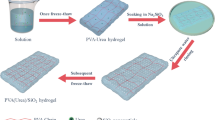Abstract
Nano-hydroxyapatite reinforced poly(vinyl alcohol) (nano-HA/PVA) gel composites has been proposed as a promising biomaterial to replace diseased or damaged articular cartilage. In this paper, the stress relaxation mechanism of nano-HA/PVA gel composites was investigated. The various influence factors on the stress relaxation behavior of the composites were also evaluated. The results showed that the relaxation mechanism of the composites was mainly determined by the synergistic effect of two stress relaxation mechanisms analogous to those of the natural articular cartilage and the polymer. The relaxation rate of the composites increased with the rise of strain ratio, but it declined with the relaxation time. Under the given strain ratio, the relaxation rate of the composite presented a trend of rising first and then falling with the increasing amount of nano-HA content. Contrarily, the normalized equilibrium relaxation modulus of the composites decreased first and then presented increasing trend with the rise of nano-HA content. Furthermore, the normalized equilibrium relaxation modulus of the composites decreased with the rise of strain.







Similar content being viewed by others
References
Coleman RM, Case ND, Guldberg RE (2007) Biomaterials 28:2077
Sinha A, Das G, Sharma BK, Roy RP, Pramnick AK, Nayar S (2007) Mater Sci Eng C 27:70
Huang ZH, Dong YS, Chu CL, Lin PH (2008) Mater Lett 62(19):3376
Pan YS, **ong DS, Ma RY (2007) Wear 262:1021
Covert RJ, Ott RD, Ku DN (2003) Wear 255:1064
Suciu AN, Iwatsubo T, Matsuda M (2004) JSME C 47(1):199
Stammen JA, Williams S, Ku DN (2001) Biomaterials 22:799
Huang HY, Liu ZH, Tao F (1997) Clin Neurol Neurosurg 99:20
Ahn ES, Gleason NJ, Nakahira A (2001) Nano Lett 1(3):149
Zhang XL, Dai KR, Tang TT (2000) Bone Joint Inj 15(1):30
Wang KY, Dai KR, Xue WD (1995) J Appl Biomech 10(4):224
Zhang XL, Dai KR, Tang TT (2000) Shanghai Med 23(12):734
Dai M, Dai KR (1998) Chin J Orthop 18(8):484
Pan YS, **ong DS, Chen XL (2007) J Mater Sci 42(13):5129. doi:10.1007/s10853-006-1264-4
Pan YS, **ong DS, Gao F (2008) J Mater Sci Mater Med 19:1963
Pan YS, **ong DS (2009) J Mater Sci Mater Med 20:1291
Pan YS, **ong DS (2009) Wear 266(7–8):699
Weng XS, Zhang JG, Zhang J, Qiu GX (1999) Acta Acad Med Sin 21(1):53
Wayne JS (1992) ASME Adv Bioeng 22:585
Wang CB, Hung CT, Mow VC (2001) Biomechanics 34(1):75
Mow VC, Kuei SC, Law WC et al (1980) J Biochem Eng 102(1):73
Mow VC, Holmes MH, Lai WM (1984) J Biomech 17(5):377
Rosa R, Finizia A, Claudio DR et al (2004) Macromolecules 37:1921
Machidaa Y, Kurokia S, Kanekiyoa M et al (2000) J Mol Struct 554:81
Nebahat D, Kalyon DM, Birinci E (2006) Colloids Surf B 48:42
Jiang XL, Jiang T, Cheng SY (2001) Polym Mater Sci Eng 17(4):116
Ji B, Gao J, Ma YZ, Gu ZQ, Liu GQ, Xue HH (2005) J Univ Sci Technol Bei**g 27(5):589
Acknowledgement
Research reported in the paper was funded by the Natural Science Research of key projects of Anhui Provincial Universities (Project No. KJ2010A099).
Author information
Authors and Affiliations
Corresponding author
Rights and permissions
About this article
Cite this article
Pan, Y., **ong, D. Stress relaxation behavior of nano-hydroxyapatite reinforced poly(vinyl alcohol) gel composites as biomaterial. J Mater Sci 45, 5495–5501 (2010). https://doi.org/10.1007/s10853-010-4607-0
Received:
Accepted:
Published:
Issue Date:
DOI: https://doi.org/10.1007/s10853-010-4607-0




